Landing Crafts: "Don't Call 'Em Boats" Say Members of Combined Ops
Canadians Were Trained on Hayling Island, Inveraray, Irvine...
Drawing by Moira Cruickshank, WRNS 1942 - 1945
Photo Credit - The D-Dday Story, page 5
Introduction:
The book Combined Operations by Londoner Clayton Marks (RCNVR, Combined Operations 1942 - 45) recounts information about the role of Canadians in Combined Ops, events or operations they trained for and participated in from 1942 'til the end of World War II, capers re a motorbike and piano, oddities of navy language and more. But after scanning the first dozen pages it is clear to readers they - just like the 950 - 1,000 Canadian sailors who volunteered for Comb. Ops. (beginning with 100 in late 1941) - will not get far without knowledge of landing crafts.
[One of the many articles on this site that mention the service of Canadians in Combined Ops begins with the title "Don't Call 'Em Boats!"]
The first photograph of a landing craft in Clayton's book appears on page 14, a few pages after an important history lesson re the Combined Operations organization (and Canada's connection to it) has been provided. I list it here:
After the evacuation of Dunkerque, Combined Operations began to take on a definite plan under the leadership of Sir Roger Keyes. It was indeed the raising of the Burning Brand; the signal proclaiming that the Allied Forces were at last prepared to rally to the offensive.
In October of 1941, Winston Churchill relieved Sir Roger Keyes of all duties as Chief of Combined Operations and appointed Comm. Louis Mountbatten as Chief of Combined Operations, with the direct order to start a program of raids of ever increasing intensity so as to keep the enemy coastline on the alert from the North Cape to the Bay of Biscay. But he stated that the main objective must be the re-invasion of France. "You must create the machine which will make it possible to beat Hitler and his associates on land. You must select and build bases from which the assault will be launched, and create training centres at which the soldiers and seamen can be trained in amphibious assault. I want you to bring in the Air Force as well and create a proper inter-service organization to produce the technique of modern assault. I want you to select the area in which you feel the final assault should take place and start bending all your energies towards getting ready for that great day. Finally, at the present, all other Headquarters in Britain are on the defensive. Your Headquarters are created to be on the offensive. "
With this new appointment and the constant pressure from Stalin and Roosevelt to start a second front, all disagreements between Sir Roger Keyes and all the other Chiefs of Staff ceased and all powers of Combined Operations were conceded to Mountbatten with the full backing of the Prime Minister.
Even while the threat of invasion still hung heavy over Britain, the earliest moves had begun. They were at first hardly discernible from necessary measures of defense. Light British ships had occasionally shelled the French coast, or attempted to break up the Channel and Biscay convoys which supplied German garrisons. Small British commando parties had descended by night on German-held ports to take prisoners, gain information and do what damage they could. By the end of 1941 these first efforts had lost some of their sporadic quality. Seamen and soldiers had begun to work out specialized landing techniques together, and were assembling into the nucleus of what would eventually become an amphibious raiding force.
This nucleus was at first entirely British; but it soon began to absorb a few of the first Canadians trained in England.

In late 1941 and early 1942, the Canadian contribution to Combined Operations was increased to fifty Officers and three hundred Ratings, who had volunteered for a specially hazardous duty with the Royal Navy. The first and second Flotillas sailed from Halifax on the "Queen of Bermuda" in November of 1941, which ran aground outside Halifax Harbour. After new sailing orders had been made, they sailed once more on the "Volendam" in December of 1941. They were shepherded to the United Kingdom by the versatile K.S. MacLachlan who, as a Lieutenant-Colonel in the Army, held the position of Deputy Minister for the Naval Service. Now "dipped" at his own urgent request to the rank of Lieutenant- Commander R.C.N.V.R., MacLachlan was to have the work of ironing out administrative problems for his charges and was to serve on British Combined Operations staffs in several theatres.
This group was then followed by the third and fourth Flotillas on the "Cameronia" in February of 1942 and again followed by the fifth and sixth Flotillas on the "Batory" in May of 1942. Other Officers and Ratings were added as required later, in 1942 and 1943 aboard the "Queen Elizabeth". For the invasions of Sicily and Italy, France and Greece and D-Day, the "Prince Henry" and the "Prince David" were added.
The newly arriving Canadians, together with some already in Britain, were to make up the personnel of the six landing craft Flotillas. They entered upon their first training at "H.M.S. Northney", the Combined Operations base which was now established on Hayling Island, east of Southampton. From there they moved on to more advanced Flotilla training in conjunction with Army personnel at another base, "H.M.S. Quebec", at Inveraray, Scotland.
Earlier in Clayton's well-detailed book we read information about these D-Day workhorses:
LANDING CRAFT ASSAULT (L.C.A.)
This craft is without a doubt the outstanding one of all Assault Craft. Extreme length 41 ft. 1.5 in. Beam (width) extreme 10 ft. 2 in. The displacement light is 8 tons with a draft of 1 ft. 1 in. forward and 1 ft. 9 in. aft. Loaded 13 tons with draft forward 1 ft. 9 in., aft 2 ft. 3 in. Fully loaded maximum speed is 7 knots. Light maximum speed 10 knots. This Craft is powered by two Ford V8 petrol engines. Its maximum carrying capacity is 35 fully equipped men, discharging them by means of a ramp. The L.C.A. at slow speeds is a most silent Craft and capable of beaching without giving away their position due to noise. It is well covered with protective plating and can resist machine gun and small arms fire. This is the type of Craft which was carried by the "Prince Henry" and "Prince David". These Crafts were used in the landings at Dieppe, North Africa, Sicily, Italy, Southern France, Greece and D-Day (i.e., Normandy).
LANDING CRAFT MECHANIZED MARK I (L.C.M.) (1) (BRITISH)
These Craft, designed to be carried and lowered from ships, used to rush ashore equipment required by the initial assault troops. Their length is 44 ft. 8 in. with a beam of 14 ft.; their displacement light is 19 tons, loaded 35 tons. The L.C.M.s are equipped with twin Chrysler engines with a loaded speed of 7.5 knots. These are all steel built but do not afford much protection against enemy fire. These Craft have done excellent work in invasions and are especially useful where larger Craft cannot approach the beach. Great endurance is required by the crews as their task is one which often lasts several weeks with the minimum facilities for food or sleep.
Please link to Photographs: Canadians in "Combined Operations", Part 1
To see more photographs with a strong connection to Canadians in Combined Operations, readers are also encouraged to link to the following post: Photographs: Aging Vets Reconnect at Reunions, Parts 1 - 3
More to follow from Combined Operations by C. Marks, and other Canadian resources.
The first photograph of a landing craft in Clayton's book appears on page 14, a few pages after an important history lesson re the Combined Operations organization (and Canada's connection to it) has been provided. I list it here:
COMBINED OPERATIONS: MOTTO - "United We Conquer"
In October of 1941, Winston Churchill relieved Sir Roger Keyes of all duties as Chief of Combined Operations and appointed Comm. Louis Mountbatten as Chief of Combined Operations, with the direct order to start a program of raids of ever increasing intensity so as to keep the enemy coastline on the alert from the North Cape to the Bay of Biscay. But he stated that the main objective must be the re-invasion of France. "You must create the machine which will make it possible to beat Hitler and his associates on land. You must select and build bases from which the assault will be launched, and create training centres at which the soldiers and seamen can be trained in amphibious assault. I want you to bring in the Air Force as well and create a proper inter-service organization to produce the technique of modern assault. I want you to select the area in which you feel the final assault should take place and start bending all your energies towards getting ready for that great day. Finally, at the present, all other Headquarters in Britain are on the defensive. Your Headquarters are created to be on the offensive. "
With this new appointment and the constant pressure from Stalin and Roosevelt to start a second front, all disagreements between Sir Roger Keyes and all the other Chiefs of Staff ceased and all powers of Combined Operations were conceded to Mountbatten with the full backing of the Prime Minister.
Even while the threat of invasion still hung heavy over Britain, the earliest moves had begun. They were at first hardly discernible from necessary measures of defense. Light British ships had occasionally shelled the French coast, or attempted to break up the Channel and Biscay convoys which supplied German garrisons. Small British commando parties had descended by night on German-held ports to take prisoners, gain information and do what damage they could. By the end of 1941 these first efforts had lost some of their sporadic quality. Seamen and soldiers had begun to work out specialized landing techniques together, and were assembling into the nucleus of what would eventually become an amphibious raiding force.
This nucleus was at first entirely British; but it soon began to absorb a few of the first Canadians trained in England.

LCM D-Day Workhorse as found in Combined Operations, page 14
Clayton's report continues:
This group was then followed by the third and fourth Flotillas on the "Cameronia" in February of 1942 and again followed by the fifth and sixth Flotillas on the "Batory" in May of 1942. Other Officers and Ratings were added as required later, in 1942 and 1943 aboard the "Queen Elizabeth". For the invasions of Sicily and Italy, France and Greece and D-Day, the "Prince Henry" and the "Prince David" were added.
The newly arriving Canadians, together with some already in Britain, were to make up the personnel of the six landing craft Flotillas. They entered upon their first training at "H.M.S. Northney", the Combined Operations base which was now established on Hayling Island, east of Southampton. From there they moved on to more advanced Flotilla training in conjunction with Army personnel at another base, "H.M.S. Quebec", at Inveraray, Scotland.
LCI(L)s, i.e., Landing Craft Infantry (Large) in a training exercise.
S. England. Photo as found on Page 23, Combined Operations
Clayton's report continues:
Already the Combined Operations force, now being built up under Lord Louis Mountbatten, was a colorful body. Methods of training were, of necessity, as fluid and unconventional as the situations with which the men would have to deal. Each cross-Channel raid - and there were many of them - brought new experience and demands for the revision of tactics, equipment and technique. "Haven't you heard? It's all been changed" - the most familiar greeting in the force - had become a byword and a slogan tacked up in its Headquarters even by the time the first Canadian draft arrived.
However unconventional, the standard of discipline and the requirements as to fitness and adaptability were very high. The first Canadian draft, and the drafts which succeeded it, soon began to take on the character of the parent organization. Canadians took part with British commando forces m some of the small, nameless raids, each of which provided its lurid adventures, brought back its quota of information and is now forgotten. There were some of our men in the important raids on Bruneval and St. Nazaire, but even by the time of the Dieppe raid in August of 1942 the Canadian Naval contribution to Combined Operations was small but vital. Among those were Lt. J.E. O'Rourke and Lt. D. H. Botly and other Canadians who were at St. Nazaire and Dieppe.
However unconventional, the standard of discipline and the requirements as to fitness and adaptability were very high. The first Canadian draft, and the drafts which succeeded it, soon began to take on the character of the parent organization. Canadians took part with British commando forces m some of the small, nameless raids, each of which provided its lurid adventures, brought back its quota of information and is now forgotten. There were some of our men in the important raids on Bruneval and St. Nazaire, but even by the time of the Dieppe raid in August of 1942 the Canadian Naval contribution to Combined Operations was small but vital. Among those were Lt. J.E. O'Rourke and Lt. D. H. Botly and other Canadians who were at St. Nazaire and Dieppe.
As the Dieppe operation entered the planning stage, high level discussion was beginning to centre about landings in North Africa. North Africa itself was a preliminary to the great descent upon the coast of France, and Dieppe was the forerunner of both. Experience had to be gained in the large-scale integration of air, sea and ground forces. The enormous difficulties of a landing from sea in the face of heavy shore defenses had to be measured in detail. Much could be planned and provided for in advance, but only an actual trial by fire could prove the worth and expose the shortcomings of training, equipment and tactics devised by large staffs through months of study. Meanwhile, the pressure for a second front was tremendous from Moscow to Washington, an understandable but impracticable answer to a political and emotional need for "something to be done".
Combined Operations, pages 4 - 6
Several pages of information is provided re LCI(L)s - a larger and later style of landing craft for transporting infantry - in Mr. Marks' book, perhaps because he trained upon them after he arrived in the UK from Canada at a later date than some of the earlier volunteers to Combined Operations.
Please note, as the war progressed in what could be considered an amphibious war (men and all materials of war had to be transported across water to foreign shores, in ships of all types and sizes, but especially by various landing crafts), a variety of absolutely necessary styles of crafts were gradually designed in larger and more efficient sizes, e.g., from the earliest LCAs and LCMs (Landing Craft, Assault capable of handling 30 - 40 men; Landing Craft, Mechanised capable of carrying more men along with more equipment and vehicles, etc., respectively) to the later LCI(L)s, LCTs, and LSTs, etc. (Landing Craft Infantry, Large capable of carrying 100+ men and many machines; Landing Craft, Tanks capable of carrying many tanks and/or 100s of men; Landing Ship, Tanks capable of carrying even more tanks and infantry).
Mr. Marks may have participated in training runs for LCI(L)s along the southern coast of England prior to D-Day Normandy, i.e., in events with names such as Operation Beaver or Yukon (certainly with a Canadian ring to them!) along the southern coast of England, as depicted below:
Help Wanted - Does this look like the coastline near Devon?
An iconic photo of LCI(L) 299 by Gilbert A. Milne, RCN Photographer
In H.M.C.S.: One Photographer's Impressions...WWII, Pg. 100 -101
LCI(L) 299 crossing English Channel with Invasion Fleet, D-day, June 6 '44
Photo G. A. Milne / DND/RCN Photo, From collection of Frank Tucker
Courtesy of Joe Phelan: Found at for posteritys sake
Ninth Brigade, Third Infantry Division move ashore on Nan White Sector of
Juno Beach in Normandy (Bernieres-Sur-Mer) on 6 June 1944.
Photo from The Public Archives of Canada.
Before taking part in D-Day Normandy and earlier operations in LCI(L)s, Canadians in Combined Ops were introduced to the much smaller (and "small vessels make small targets," said my father) LCAs and LCMs as early as January or February 1942 at training camps HMS Northney (1 - 4) on Hayling Island (near Havant on the south coast of England). Some were shown drawings of the crafts by Moira Cruickshank (see below) and some recall practice landings on the actual crafts.
Drawings by M. Cruickshank (and more details) - click here The D-Day Story
More details about Canadian sailors at HMS Northney (1 - 4) can be found on a short video here.
Below, readers can see LCMs and LCAs used in Sicily, July, 1943:
As found in Combined Operations by Clayton Marks, pg. 24
This craft is without a doubt the outstanding one of all Assault Craft. Extreme length 41 ft. 1.5 in. Beam (width) extreme 10 ft. 2 in. The displacement light is 8 tons with a draft of 1 ft. 1 in. forward and 1 ft. 9 in. aft. Loaded 13 tons with draft forward 1 ft. 9 in., aft 2 ft. 3 in. Fully loaded maximum speed is 7 knots. Light maximum speed 10 knots. This Craft is powered by two Ford V8 petrol engines. Its maximum carrying capacity is 35 fully equipped men, discharging them by means of a ramp. The L.C.A. at slow speeds is a most silent Craft and capable of beaching without giving away their position due to noise. It is well covered with protective plating and can resist machine gun and small arms fire. This is the type of Craft which was carried by the "Prince Henry" and "Prince David". These Crafts were used in the landings at Dieppe, North Africa, Sicily, Italy, Southern France, Greece and D-Day (i.e., Normandy).
LANDING CRAFT MECHANIZED MARK I (L.C.M.) (1) (BRITISH)
These Craft, designed to be carried and lowered from ships, used to rush ashore equipment required by the initial assault troops. Their length is 44 ft. 8 in. with a beam of 14 ft.; their displacement light is 19 tons, loaded 35 tons. The L.C.M.s are equipped with twin Chrysler engines with a loaded speed of 7.5 knots. These are all steel built but do not afford much protection against enemy fire. These Craft have done excellent work in invasions and are especially useful where larger Craft cannot approach the beach. Great endurance is required by the crews as their task is one which often lasts several weeks with the minimum facilities for food or sleep.
[Editor's Note: The LCM is the craft most familiar with many Canadian sailors, including my father.]
LANDING CRAFT MECHANIZED MARK III (L.C.M.) (3) (U.S.A.)
A newer type of L.C.M. designed and built in the U.S.A. and used in great numbers by the R.N. They are designed to carry a load of 30 tons. Their length is 50 ft. and beam 14 ft. Their displacement light is 22 tons, loaded 52 tons. They are powered with twin Gray, Buda or superior Diesels, the first named having proved itself the most sturdy. The advantage of this Landing Craft is the fact that it is quite seaworthy and capable of cruising about 1,000 miles at a speed of 6 knots. The maximum speed of the Gray Diesels is 8 knots with a full load.
 Photo Credit - Canadians at Arms
Photo Credit - Canadians at Arms
LANDING CRAFT MECHANIZED MARK III (L.C.M.) (3) (U.S.A.)
A newer type of L.C.M. designed and built in the U.S.A. and used in great numbers by the R.N. They are designed to carry a load of 30 tons. Their length is 50 ft. and beam 14 ft. Their displacement light is 22 tons, loaded 52 tons. They are powered with twin Gray, Buda or superior Diesels, the first named having proved itself the most sturdy. The advantage of this Landing Craft is the fact that it is quite seaworthy and capable of cruising about 1,000 miles at a speed of 6 knots. The maximum speed of the Gray Diesels is 8 knots with a full load.
Combined Operations, page 13
Below readers will find a few supplementary photos concerning landing crafts and their landing zones used in Sicily, beginning on July 10,1943:
From They Left the Back Door Open by Lionel Shapiro
From They Left the Back Door Open by Lionel Shapiro
(The above two photos face pages 14 - 15)
From They Left the Back Door Open by Lionel Shapiro
(Facing page 30)
LCAs and LCMs were often seen working together; LCAs with troops, LCMs with their supplies. My father and mates landed near Avola (see below, west of GREEN and AMBER Beaches) in LCMs beginning on July 10, 1943, at JIG Beaches (see below). Other Canadian flotillas of landing craft also landed at GEORGE and HOW Beaches. Email me at gordh7700@gmail.com for more details or with any questions or comments:
 Photo Credit - Canadians at Arms
Photo Credit - Canadians at ArmsU.S. troops led ashore from an LCA by Canadian D. Harrison (right), Nov. 1942
Photo Credit - Articles re Jews of Algeria, Morocco by S. S. Ochayan
sailing past the Princess Iris, our Landing Ship Stern Chute. The LCMs precede
in line ahead of us. Photo: David J. Lewis, as found in St. Nazaire
to Singapore, The Canadian Amphibious War, Vol. 1, page 53
Craft, Personnel) were used in various capacities, many made of plywood.
Caption: No. 3 Commandos train on the Isle of Wight. They were critical of
travelling in plywood boats but didn't seem to mind sitting under 16 gallon
cans of petrol ready to go up over their heads. Photo: David J. Lewis. Link -
Go to Page 5 of St. Nazaire to Singapore, Canadian Amphibious War,
for more information about Higgins boats
Canadian-made wooden boats were also used during World War II, at least on the west coast of Canada, e.g., for training purposes at HMCS Givenchy III at Comox, Vancouver Island:
This photo and the next one below were taken by Robert Berger, RCNVR, and
are found on page 104, in the same textbook as mentioned above w previous
photo. Comox is in the background, to the left side of the small bay.
This photo was taken in Courtenay, about 1 - 2 miles from Comox.
The LCM (Wooden) is parked in the Courtenay Slough, 1944 - 45
A memorial plaque re the Courtenay Slough can be found near the entrance to Simms Millennium Park, just east of the downtown in Courtenay, B.C.:
The bronze plaque is visible on the ground, right of red bushes. GH
The next three photos are from Combined Operations by Clayton Marks, page 24:
LCMs, the workhorse, in service carrying troops and supplies, Sicily
The last two photos are from the large collection found at Imperial War Museum (IWM), UK:
LCM in foreground with LCA about to pass its bow. Photo IWM
LCI(L) on the left, an LCT (Tank) on the right, near the beach in Sicily, 1943
Please link to Photographs: Canadians in "Combined Operations", Part 1
To see more photographs with a strong connection to Canadians in Combined Operations, readers are also encouraged to link to the following post: Photographs: Aging Vets Reconnect at Reunions, Parts 1 - 3
More to follow from Combined Operations by C. Marks, and other Canadian resources.
Unattributed Photos GH












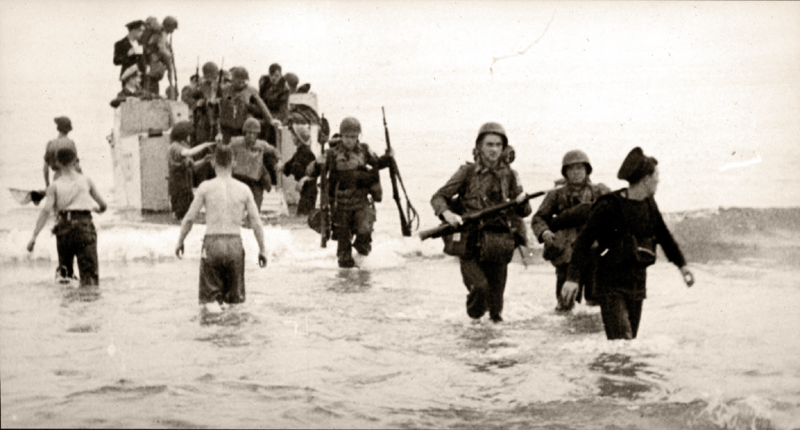



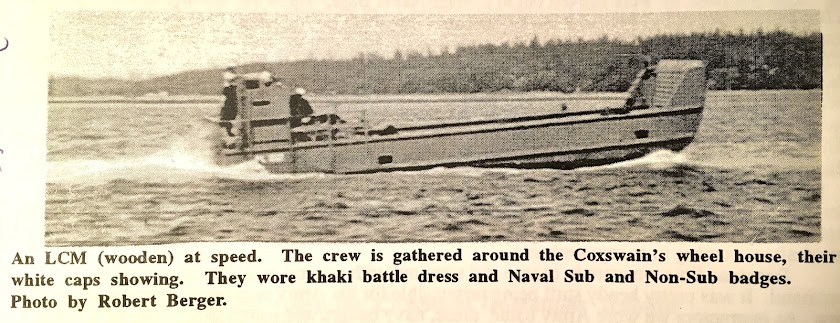

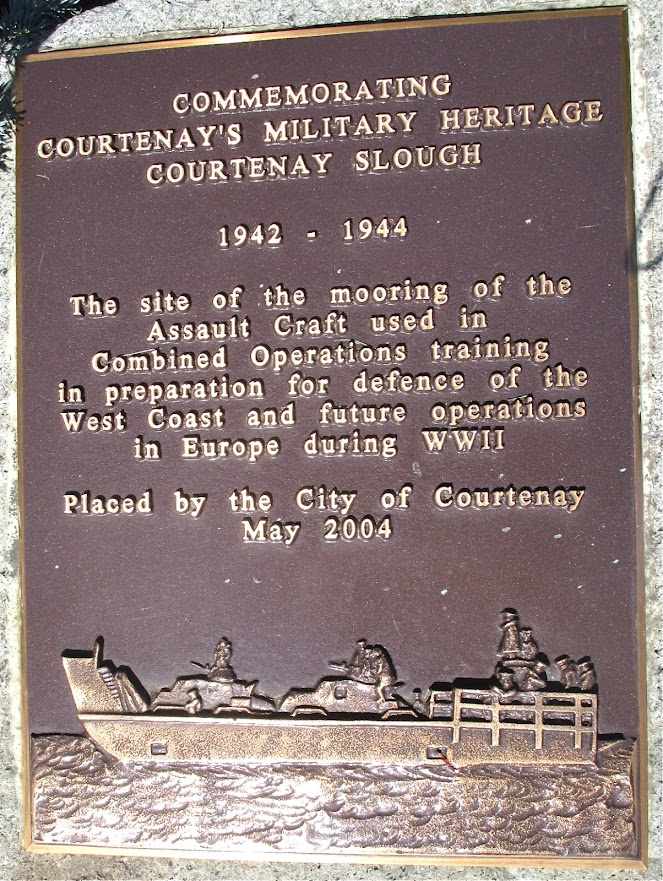



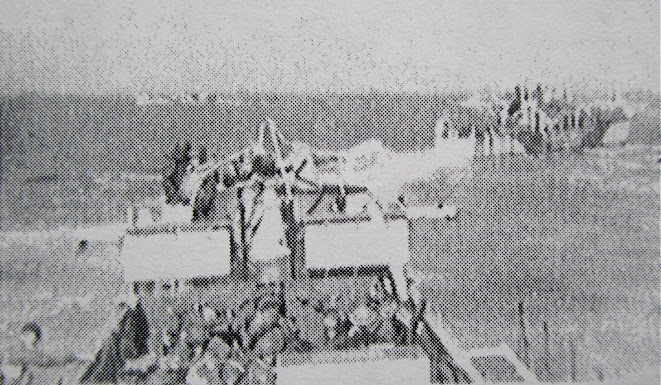


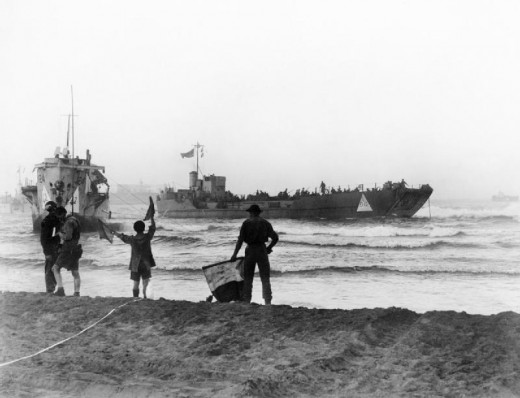
No comments:
Post a Comment